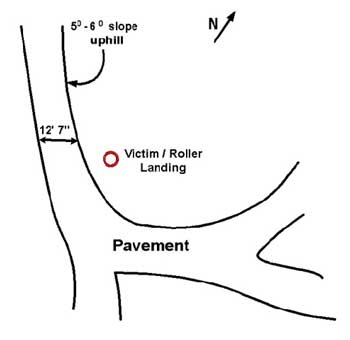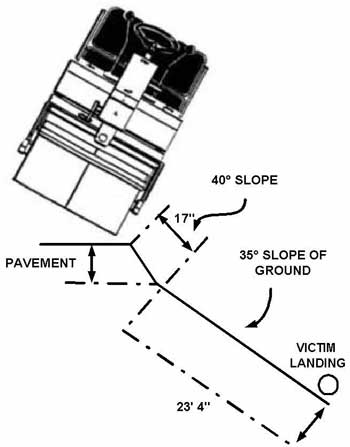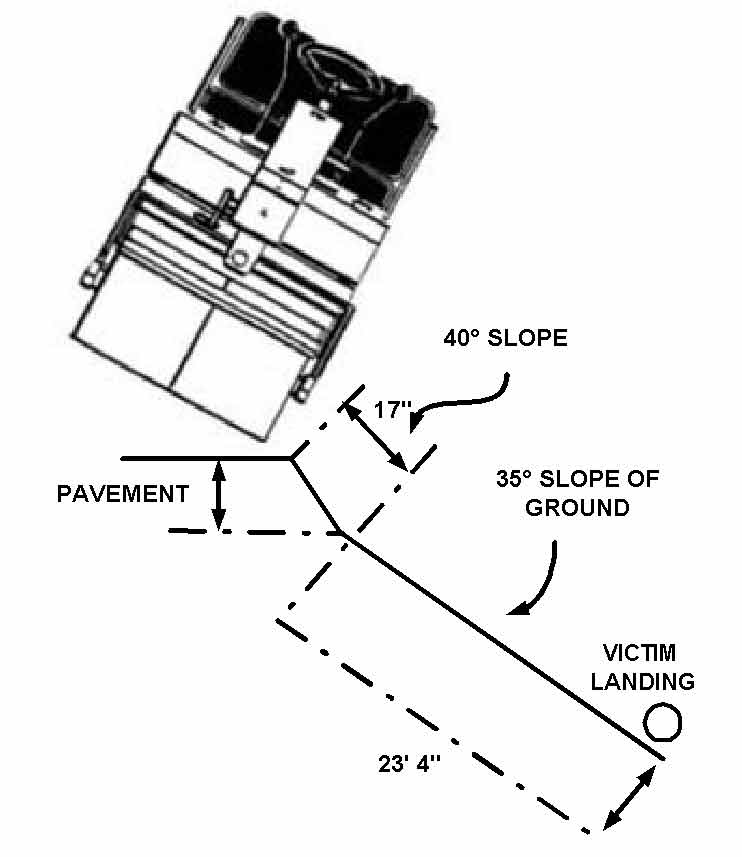Twenty-Nine-Year-Old Asphalt Compactor Operator Dies From Crushing Injuries Received During Machine Rollover – North Carolina
NIOSH In-house FACE Report 2000-20
Summary
On July 10, 2000, a 29-year-old equipment operator (the victim) was killed when the asphalt compactor he was operating slid off the pavement, down an embankment (Figure 1) and overturned, trapping him beneath. The victim was part of a five-person crew that was contracted to pave a private residential driveway which was located on a wooded lot on hilly terrain. One witness to the incident reported that he saw the victim position the compactor close to the edge of the driveway. It appeared that the smaller front roller of the compactor became caught on the pavement edge. With part of the front roller hanging over the pavement edge, the witness reported that the victim started to reverse the compactor when the larger back roller slipped sideways over the edge of the pavement. When the compactor started to slip, the victim apparently tried to jump clear, but his leg become entangled and he went over the embankment with the compactor. Coworkers immediately ran over the hill to aid the victim while the property owner called 911. While waiting for emergency medical services (EMS) to arrive at the site, coworkers removed the victim from underneath the compactor and attempted to administer first aid. EMS and fire department crews arrived at the site and transported the victim to the hospital, where he was pronounced dead.
NIOSH investigators concluded that, to help prevent similar incidents, employers should:
- ensure that all equipment used in a location where there is a danger of overturn be equipped with a Rollover Protective Structure (ROPS) and that operators are trained to wear seat belts when operating machinery equipped with ROPS
Additionally, operators should
- use extra caution when using heavy equipment on steep or hilly terrain
Introduction
On July 10, 2000, a 29-year-old equipment operator (the victim) was killed when the asphalt compactor he was operating slid off the pavement, down an embankment and overturned, trapping him beneath. On July 24, 2000, the National Institute for Occupational Safety and Health (NIOSH), Division of Safety Research (DSR) was notified of the incident by the North Carolina Department of Labor, Bureau of Safety Compliance, and initiated an investigation. On August 17, 2000, a DSR safety and occupational health specialist met with the state compliance officer to discuss the case and to review information collected during the course of his investigation. The incident site was not visited since it occurred at a private residence and the owners refused access.
The employer was a paving company which was a subsidiary of a larger paving corporation that had similar operations located throughout North and South Carolina. There were approximately 400 employees working for this paving company at the time of the incident, of which five were assigned to complete the residential paving contract where the incident occurred. The employer provides both formal classroom training and informal toolbox talks to all company employees. The various types of training which employees received is documented and updated, when required. The employer has a full-time safety director on staff, with additional support provided by the corporate safety and health manager.
Back to Top
Investigation
The paving company that the victim worked for was contracted to pave a long driveway (Figure 2) located at a private residence. On the morning of July 10, 2000, a work crew arrived at the work site at approximately 8:30 a.m. The foreman of the crew began the morning by walking the job site looking for any potential problems that could impede the paving operations. Once completed, he held a tool-box meeting with the crew to go over specific job hazards. One of his concerns was the terrain at the job site, in particular the drop-off along the east edge of the driveway (Figure 3). The work site was located in a wooded area and the driveway was on hilly terrain. The foreman told the crew to be careful of the edges near the drop-offs, and to stay with the asphalt trucks and to guide them as they backed their way to the paver. Shortly after the tool-box meeting, asphalt trucks started arriving at the site and paving operations began. Work laying pavement progressed throughout the morning without incident. Workers had reported that they told the victim twice during the morning to keep the compactor rollers off the pavement edges because this created a soft spot that had to be fixed by hand.
The victim was operating a small, two roller, single-seated pavement compactor, with an unloaded weight of approximately 2000 pounds (Figure 4). The front steering roller consisted of a split drum measuring 20 inches in diameter and 30 inches in length, with each drum weighing approximately 100 pounds when filled to capacity with 12 gallons of water. The rear roller was a single drum, measuring 24 inches in diameter and 36 inches wide, and weighed approximately 530 pounds when filled to capacity with 63 gallons of water. The compactor was propelled to a maximum of 4 miles per hour (mph) from a 16-horsepower gasoline engine. The roller could move forward and backward by a two-speed hydrostatic transmission, and braking was accomplished with a dynamic braking system. The dynamic braking system required movement of one of two connected levers to operate. These levers, when pushed forward resulted in the compactor moving forward. As the lever was moved back to upright neutral positions the compactor braked to stop position. If the lever was moved further back past the neutral position, the compactor reversed direction. The compactor also had a back-up, hand-operated caliper brake for emergencies.
At approximately 12:30 p.m., the victim was compacting asphalt on the edge of the driveway. A witness reported that he saw the victim position the compactor close to the edge, with the front roller partially over that edge. With part of the front drum hanging over the pavement edge, the victim reversed the compactor and the back roller slid toward the edge. The compactor then started to tip over the edge of the pavement toward the embankment. The witness saw the victim attempt to jump back toward the pavement as the compactor went over the embankment, however, it looked to him like the victim had caught his leg on something on the compactor roller and went over the embankment with the machine. The edge of the asphalt was sloped 40 degrees for 17 inches to the dirt berm of the driveway where the embankment began. The embankment had a 35 degree slope and extended 23 feet down to the landing area of the roller. Two coworkers ran over the embankment to aid the victim, while the property owner called for emergency medical services (EMS). The two coworkers at the site removed the victim from underneath the roller and started administering first aid. Shortly after being called, EMS personnel arrived on site and transported the victim to the hospital, where he was pronounced dead.
Back to Top
Cause of Death
The medical examiner listed the cause of death as severe head trauma.
Recommendations and Discussion
Recommendation #1: Employers should ensure that all equipment used in a location where there is a danger of overturn be equipped with a Rollover Protective Structure (ROPS) and that operators are trained to wear seat belts when operating machinery equipped with ROPS.
Discussion: All equipment operated in a location where there is the potential for a rollover to occur should be equipped with ROPS. Most new equipment already has ROPS and seat belts installed by the manufacturer. In addition, most manufacturers offer a ROPS retrofit for older equipment. The compactor involved in this incident was being used to compact asphalt in close proximity to an unguarded 35-degree sloped embankment without being equipped with rollover protection. A Rollover Protective Structure (ROPS) is only effective when used in conjunction with a seat belt. Seat belts are incorporated into the design of the ROPS to restrain the operator in the operator’s seat and within the confines of the protective structure in the event of a sudden stop or rollover of the equipment. Failure to use seat belts in conjunction with ROPS has proven to be hazardous to equipment operators during a rollover. Employers should train workers to wear the seat belt and not to jump from the equipment in the event of a rollover. The manufacturer of the compactor involved in this incident did offer ROPS as a purchase option (less than $500).
The construction industry has long recognized the hazard of rollovers and tipovers with respect to compactors. The Society of Automotive Engineers (SAE) adopted performance criteria for ROPS when used on a variety of different machines, including compactors.1, 2 If a manufacturer or owner installs ROPS on a compactor, it must meet a specific SAE minimum level of performance. OSHA does not have specific regulations for requiring ROPS or seat belts on compactors. It is OSHA’s position that the hazard of equipment rollover is a “recognized” hazard within the meaning of the General Duty Clause (Section 5(a)(1) of the Occupational Safety and Health Act), and that ROPS and seat belts are feasible in many situations to reduce this hazard for compactors.3
Recommendation #2: Operators should use extra caution when using heavy equipment on steep or hilly terrain.
Discussion: Although using this model compactor on a slope such as the one encountered in this case is not unusual and is mechanically acceptable, operators should use extra caution when using heavy equipment on steep or hilly terrain. Paying close attention to the terrain of the area can help reduce the risk of injuries due to rollovers and other hazards.
References
- SAE [1994]. Earth moving machinery-seat belt and seat belt anchorages. Warrendale: PA. Society of Automotive Engineers, ISO6683, Standard J1040.
- SAE [1997]. Operator restraint system for off-road work machines. Warrendale: PA. Society of Automotive Engineers, Standard J386.
- OSHA [1998]. OSHA Standards Interpretation and Compliance Letters: ROPs/seatbelts for roller compactors; lockout/tagout in construction. Washington, DC: US Department of Labor, Occupational Safety and Health Administration. Information found at www.osha-slc.gov/OshDoc/Interp_data/I19980316B.html. (last accessed May 30, 2001)
Back to Top
Investigator Information
This investigation was conducted by Joseph E. Burkhart, Safety and Occupational Health Specialist, NIOSH Division of Safety Research, Surveillance and Field Investigation Branch, Fatality Assessment and Control Evaluation Team.
Photograph and Figures

|

|

|

|
|
Fig. 4. Asphalt Compactor Involved in Incident
|
The FACE investigation project is the cornerstone of the overall NIOSH program to prevent occupational fatalities. The objectives for this effort include the investigation of occupational fatalities to assess and characterize the circumstances of these events in order to develop succinct descriptive and evaluative reports for distribution to occupational safety and health groups across the country. This work is being conducted by the FACE investigation team. It is expected that the reports alone will have a major impact by better defining the causal factors behind occupational fatalities, calling national attention to the problem, and providing insights into the prevention efforts that are needed. However, the program does not determine fault or place blame on companies or individual workers.
